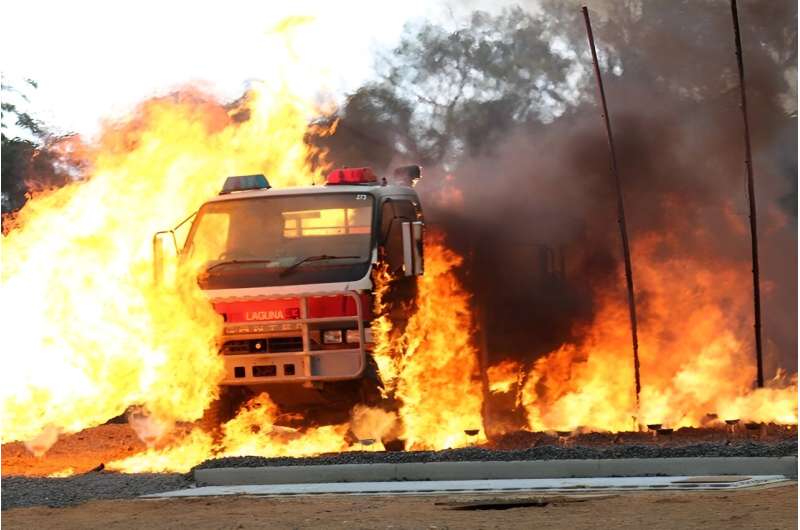This article has been reviewed according to Science X's editorial process and policies. Editors have highlighted the following attributes while ensuring the content's credibility:
fact-checked
trusted source
proofread
Fire-tested systems help crews survive truck burnovers

Terrifying moments when flames can overrun and burn over a fire truck are called flashover or burnover.
While firefighters have strategies and operational procedures to minimize risk, these dangerous events still occur and can be fatal. Our research is helping firefighters survive these dire situations.
We have collaboratively developed burnover protection systems for crew-cabins in fire trucks for more than 20 years. These systems are now fitted as a standard requirement in all Victorian fire trucks. Fire departments in other states are also developing prototypes using this knowledge base.
The road to crew protection from burnovers
Following some tragic burnovers in the late 1990s, the Victorian Country Fire Authority (CFA) and the New South Wales Rural Fire Service (RFS) asked for our help. We worked with them to develop safety parameters for fire trucks and to test the effectiveness of modifications like water sprays and shielding.
We designed a series of 24 tests carried out on two fire tankers at the RFS's Hot Test Fire Facility at Mogo in New South Wales (NSW). Our testing used a number of gas burners to simulate the approach of a bushfire front and the burnover of the fire trucks. This simulator used our detailed knowledge of fire front characteristics and behavior to accurately recreate burnover conditions similar to a real bushfire. The simulator subjected the fire trucks to varying fire intensities while we recorded detailed measurements of radiation, temperature and toxic gases.
New and better crew protection systems for burnovers
The data we collected during the Mogo tests informed new and better prototypes for crew protection. We tested these prototypes using worst-case burnover conditions in the simulator.
Field experiments in Tumbarumba (NSW) and Brucknell Park (Victoria) further validated the systems. These forest burnovers provided additional confidence in both the protection system design and the exposure conditions achieved in the simulator.
Fire trucks have been fitted with key features to support safety and survival since 2006:
- a ring of spray nozzles that deliver water over the vehicle's cabin
- radiant heat shields or curtains for windows to block radiation from reaching the people in the cabin. These inclusions also provide an extra layer of protection if the windows break
- water sprays to stop wheels and pumps catching alight
- fire resistant covers for electrical, pumps, air intakes and air hoses.
The effectiveness of these new crew cabins was put to the test in a major way during the fire outbreak of 2009. During the 2009 Black Saturday fires in Victoria, 12 fire trucks were impacted by fire and all their crews emerged safely with no loss of life. These protection systems continued to provide crews with increased safety in subsequent fires including the more recent 2019–2020 bushfires.
Bushfire science supporting the nation
Our crew protection system testing is another example of how controlled experiments, science and innovation is helping safeguard people. We also test and validate a wide range of other infrastructure to withstand bushfires including houses, power poles, fences, shelters and water tanks.
In 2021, we teamed up with Suncorp and other partners to create a prototype house that could survive the extreme events of a fire, tropical cyclone and flood.
Named One House, the project's researchers collaboratively chose materials and design principles that would enable the house to survive each of these extreme events—something never attempted before. Our researchers returned to the Mogo facility to "try to burn the house down" and run the bushfire testing.
Improvements to crew cabins and houses helps build bushfire resilience as Australians face increased extreme fire weather into the future.



















